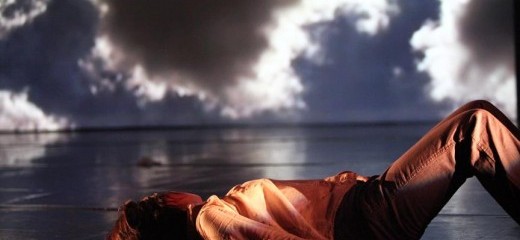
Photo: Bill Hebert
dance fueled. writing driven.
by Ellen Gerdes & Kilian Kröll
Assignment: The nEW Festival presented four new works by its
2012 resident choreographers.
Ellen Gerdes and Kilian Kröll attended, between them, four performances, Wednesday through Saturday, at the Painted Bride Arts Center. They each wrote about the pieces, then mashed their words together. The festival aimed to explore “innovative methods of dance curation.” We aimed to explore innovative methods of dance writing.
Beau Hancock’s duet poor lost sometimes boys is sweet but unsentimental. Like a deer that loves to be caught in the headlights, Scott McPheeters enters the stage. He looks curious. With quiet elasticity, he rolls off his feet and regains his balance. Birds chirp, water rushes. Clean and unexpected direction changes mark his dance. McPheeters is a sexy bird of paradise, clad in cut-off jeans, yellow leather jacket and triple-layered shirts with popped collars. A window cut into his costume reveals his naked back. It’s designed by Patricia Dominguez. (I want to wear this to the club.) In similar dress, the choreographer joins his partner-in-life onstage. Their bodies know each other well. Hancock always almost smiles. A computer voice reads a poem that Hancock wrote. “Racking their brains for the answers to the questions, the questions that keep them restless and fettered, the questions that boil their balls and make their cocks hard with unrequited lust.” The “sometimes boys” move with swift precision, side-by-side, sometimes touching, holding hands. This dance is about natural artifice. Hancock’s bare back acts as a projection screen for a video of himself, creeping through dried grass. He moves away and leaves a projection in the shape of his body behind him on the scrim. The couple poses, struts off, throwing it all away.
Jung-eun Kim collects a row of paper planes from the front of the stage while footage of birds at a lake lights up the back scrim. After that she stands center stage in a single spotlight and points, with deliberate caution, at the space behind the audience. Her face is soft, her pace is slow. Lucas Brown’s guitar and synthesizer loops come from scratchy speakers. Kim walks with arms outstretched, turns at times, leans back, gathers something up. Staying and Going is the title of her piece. Wobbly video of the sky and a dull peach shirt complement the tentative modulations of her steps.
The House of Empty is actually full: a scaffold to the right, green barrel to the left, rocks strewn about. Jodi Obeid employs five diverse bodies to tackle the set. Justin Jain teeters on his seat and cackles with force. He is the laughing trickster. Marie Brown, the mute and hooded gnome, bravely throws herself among the rocks and etches writing in the air. Adams Berzins, a father figure in a tan jumpsuit, counts out rocks on a diagonal line across the stage. A teenager, David Rubio, practices his double turn jumping off these rocks. “Come on,” his mother begs. She’s played by Katherine Keefer Stark. He falls. She obsesses over this event throughout the piece, repeating in various inflections: “Did you hurt your knee?” She contrasts her soft, fluid movement with the harsh feeling of this vacuous reality. It’s a haunted house set to sounds of Jain’s continual laughing and the theater’s dripping water, ringing telephones, creaking doors. The House becomes abrasive: the archetypes dissolve in well-rehearsed chaos and finally all chant: “We’re wasting time. I don’t like this.”
A circus announcer opens Daniele Strawmyre’s Cant with this alluring proposal: “Who wants to see the world’s biggest baby?” The question hangs in the air, but it’s forgotten a minute later. Instead, an awkward caravan of carnival characters moves across the stage. “Indian princesses” fidget as they show off their full-body tattoos – “native illustrations.” A fire-eater seduces the audience with her talent; the rest of the circus cast has less natural stage presence. A silhouette behind the scrim reads historical P.T. Barnum quotations about the theater as an “edifice for delight.” The dancers give us much to describe. Portraying conjoined twins, David Konyk and Hedy Weiland rolled across the floor and lifted each other in a darling full-contact duet. Strawmyre as a long-haired bearded lady, wearing a white dress and knee pads, touches her face. Her focus and her choreography are diffuse. She swings her hair extensions out of the way as she rolls across the floor. Gillian Chadwick sings a song in between two childlike Kate Watson-Wallaces: one twirls and stretches to the floor while the other, a life-size video clip, doubles her image. Mostly in canon, they meet in unison in the last verse.
Before we know it, the caravan has moved on.
nEW Festival, Painted Bride Arts Center, January 18-21, 2011. Co-directed by Nora Gibson, Megan Mazerick, and Karl Schappell, nEW also included pay-what-you-want technique classes with Bethany Formica Bender and the Dancehouse showcase by former nEW resident artists. No further performances.
Editor’s Note: Beau Hancock is our colleague at thINKingDANCE.
By Kilian Kröll
January 25, 2012

